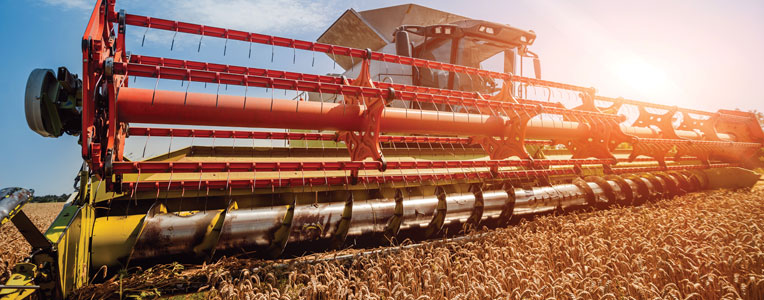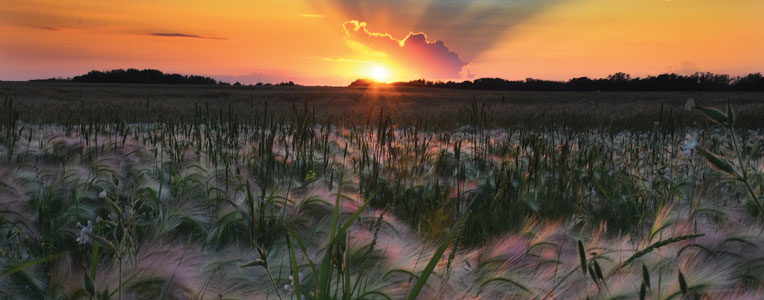Our Prairies Regional Report finds that business for many lawyers in Saskatchewan and Manitoba can rely on the ancient basics.

With low oil prices and strained relations with the United States, business for lawyers in the prairie provinces of Saskatchewan and Manitoba can rely on the ancient basics.
“Things like mining, oil and gas production, construction, commercial real estate are still feeling the pinch from the downturn in the economy,” says Jeff Grubb, Saskatchewan’s managing partner of Miller Thomson LLP.
“One of the areas though, that — remarkably, we think — has kind of weathered through the economic downturn and has maintained a fairly consistent level of growth is agriculture,” he says.
The price of farmland is increasing or holding at record highs, those selling machinery and manufacturing implements are doing well and wind farms are driving growth in renewable energy, he says.
Over the last 20 years, agribusiness has seen the consolidation of farms and the aging of farm operators, producing a steady need for legal advice.
Around $50 billion worth of farm assets is expected to be transferred to new ownership in the next decade, according to Christopher Masich of McKercher LLP writing for Global Ventures Magazine. With the average age of a Canadian farmer at 55 and the fact that only eight per cent of farm operators have succession plans in place, the opportunities are bountiful for lawyers in the wills, trusts and estates field.
“They are now thinking about how do we transition that to the next generation,” says Grubb. “We’re seeing more and more that farmers are doing that. It is very much a growth industry in Saskatchewan for legal service providers, assisting with developing estate plans, tax plans, corporate structures, all of that kind of work to be done.”
The trend of consolidation is continuing. The number of farms has decreased by almost six per cent since 2011, but during that period, the area used for cropland increased by nearly seven per cent, according to the 2016 Census of Agriculture.
“There definitely is a trend of farms becoming larger and larger that’s been happening over the course of, I would say, the last 20 to 25 years, and there’s no indication that that trend is going to reverse itself any time soon,” he says.
Despite this consolidation, Grubb says, farms are still primarily family operations and the family farms are becoming more business-like in their approach and structure, something Grubb knows well. He runs a grain farm and has been farming all his life. His son manages the daily operations, while Grubb attends to his law practice, which includes many clients in agribusiness.
“It’s not unique in Saskatchewan in the sense that many of us from Saskatchewan are not very far from the farm or rural background,” he says. “Having a knowledge and understanding of agriculture is pretty important in terms of serving the clients that I deal with.”
Don Wilson, managing partner of MLT Aikins LLP, a firm that brands itself as Western Canada’s law firm, says relatability from a shared business culture and approach to clients helped in the 2017 merger that brought together MLT and Aikins in 2017.
“Prairie people are prairie people. There’s a certain intangible there, whether you’re from Winnipeg or Swift Current or Medicine Hat. You’re different, but you’re the same,” says Wilson.

Manitoba’s Aikins MacAulay & Thorvaldson LLP had been in operation since 1879, nine years after the establishment of the province and only a decade after Louis Riel led the Red River Resistance. MLT was founded in 1920 and MLT Aikins now has more than 240 lawyers in Winnipeg, Regina, Saskatoon, Calgary, Edmonton and Vancouver.
Clients in this part of the country require different treatment from their advisors than someone from Manhattan or Bay Street, says Wilson.
“So many of our clients say that they coached the same hockey team as some other lawyers here, and their kids are on the same team,” he says. “That matters to people.”
People talk to each other on elevators in the Prairies, says Wilson, adding that his firm is finding clients respond to the fact the firm has focused its growth in the west rather than the east. But aside from culture, their intention is to offer the Prairies big-firm service without their clients having to dial a 416 number.
“Any of this hokey ‘we’re all prairie folk’ doesn’t get you anywhere if you’re not providing first-class service,” he says.
Because of a flurry of regulations from the law society, Glen Peters, managing partner of Fillmore Riley LLP in Winnipeg, has seen the borders become blurred in the last decade, affording lawyers the opportunity to practise across provincial lines.
“I’m more likely now to see, for example, an Alberta lawyer on the other side of a real estate transaction with me here than I would have seen five to 10 years ago. And they would probably tell you the same thing in their jurisdiction.”
But when it comes to the border to the immediate south, Peters says, the prairie region is going from close-to-home north-south relationships to far-east-west connections.
“We’re seeing an increased interest from eastern Asian-based companies in in our jurisdiction,” he says. “And there’s obviously political reasons for that.”
Fillmore Riley has a large small-business base, which includes many in farming and dairy production. Those clients are experiencing a pronounced political uncertainty, making long-term planning impossible with NAFTA/USMCA negotiations and tariff wars, says Peters.
“I’m not sure that it’s unique to the agribusiness. It’s something that we are dealing with across the board with our small business space,” says Peters.
Peters, whose practice balances between firm administration management and his small business, commercial real estate and lending practice, says he’s seen growth in IT, with a spate of public-private partnerships due to effective marketing of the region by Winnipeg.
Historically, Fillmore Riley practised primarily in insurance defence, banking and finance. Now, its client base is largely family-owned businesses, some major international companies, financial institutions, insurance companies and public and professional regulatory bodies, says Peters, who has been with the firm since articling there in 1985.
“It’s been a growth from a small, specialized practice into a pretty much full-service regional firm,” he says.
Around eight years ago, high commodity prices buoyed Saskatchewan’s economy. But as a barrel of oil lost two-thirds of its value, industry diversity was key to MLT Aikins LLP’s ability to absorb that price volatility, says Wilson.
While many of its clients are in oil, potash, uranium, hard rock and other commodities, the firm has large IP, technology, privacy and tax litigation practices and are “very strong” in the health sector, he says.
“Rather than being dependent on certain sectors and certain practice areas, we have tried to be nimble enough over the years that we’ve developed other practice areas that continue to be strong, irrespective of some of these turns in the economy,” he says.
Wilson says the firm does not just stay diverse in the sectors its practice touches, it narrows its practice specialties and provides a variety of them.

“The world is going in the way of specialties,” he says. “We don’t just have people who just litigate. They do estate litigation or they do class action litigation.”
The full-service firm also handles clients in transportation, agribusiness, banking, insurance, real estate and infrastructure, and it has an Aboriginal law practice as well.
While many lump the west together, Wilson says Manitoba is “by far” the most diverse economy of the four western provinces, with a strong manufacturing sector and financial services sector, while being the transportation centre of the country.
Known as the gateway to the west — like a Canadian Istanbul connecting Europe to the silk road — Winnipeg exploded upon completion of the Canadian Pacific Railway in 1885. With a flood of immigrants drawn by high wheat prices and a seemingly boundless prairie, Winnipeg became the frontier capital and conduit to the western half of the country.
“Nothing is recession proof, but I think the wide variety of strong features of [Manitoba’s] economy probably is about as close as anything to that,” Wilson says. “It’s a good place to be. . . . It’s a very stable market as well.”
“A lot of these areas are specialty areas that really transcend, generally, economic ups and downs,” Wilson says.
Winnipeg’s geographic isolation, connecting the Canadian Shield to the open plain, is what necessitated the development of a diversified economy, says Peters.
“You don’t see the peaks and valleys, you don’t see the booms and busts,” he says. “You know, when the world changed in 2008, it didn’t change much around here. So, it is kind of a unique ‘captive market.’”
While Peters says critics lament a lack of “boom opportunities,” the stability is “absolutely the strength of this region.”
Manitoba, Saskatchewan and Alberta collaborate in terms of legal profession regulation, with their respective law societies joined in many initiatives, including those focused on alternative legal service provision, entity regulation and access to justice.
In Saskatchewan, the legal services task team was appointed in 2017. A joint initiative between Saskatchewan’s justice ministry and law society created a list of recommendations, which included allowing the law society to allow certain non-lawyers to practise law “with a limited license on a case-by-case basis.” It also recommended adjusting the Legal Profession Act to allow more flexibility for future developments of this type and expanding the list of exceptions to the prohibition against practising law, for example in the case of a non-lawyer preparing documents to be used in an action.
The legal services task team report concludes that much of the unmet legal service need in Saskatchewan comes from a deficit in “entry-level information” about legal rights and responsibilities. Many consumers who are repelled by the notion of hourly fees are reluctant to seek out even elementary details, says the report, and a distinction between legal advice and legal information is blurred. The authors call for more clarity about who can provide legal information and what constitutes the unauthorized practice of law.
The task force also called on legislators to amend the act to allow new categories of law society membership for “alternative service providers.” The prairie law societies understood this would likely require regulating entities, according to “Innovating Regulation,” a discussion paper produced by the three law societies. This would be a change from the law societies’ traditional role regulating individual lawyers.
The prairie provinces have a history of collaboration in legal profession regulation and engaged in consultations on these issues, says Tim Brown, a Regina-based lawyer and executive director of the Law Society of Saskatchewan.
“Manitoba, Saskatchewan and Alberta are building a resumé of working together on some significant programs and really building a relationship and a history of working together,” Brown says. “This type of collaboration is going to be more significant going forward.”
Through the prairie partnership, the respective law societies are devising methods and plans for entity regulation.
“We’ve worked together on this project for over a decade,” says Brown. “We’re in the process of redeveloping that program to ensure that it equips the lawyers of tomorrow with the competencies that they require.”
Entity regulation will shift law societies from a reactive to proactive role, going from policing the profession to working in partnership with firms to create built-in best practices to insert into their systems to eliminate unethical behaviour at the root, says Brown.
As of April 2019, all firms in Manitoba will have to register as firms with the law society and will be required to get approval from the law society to maintain a trust account, says Kris Dangerfield, CEO of the Law Society of Manitoba. Those designated as trust account supervisor will also have to complete a trust account education program.
“The rationale for the program, of course, is that the public will be better protected and that the number of claims associated with mismanagement of trust funds will be significantly reduced,” she says.
“So that’s a pretty significant change for us in Manitoba.”
With access to justice an issue in the legal profession, spanning the country and beyond, the Manitoba Law Society has convened a “president’s special committee on alternate legal service providers” to explore possibilities. The committee found that debtor/creditor and other consumer law matters, employment, estate, discrimination, family, health and disability, personal injury, housings, benefits and immigration had the greatest need for expanded services.
“This is an era where we can’t take public trust for granted,” says Byron Williams, director of the public interest law centre of legal aid Manitoba.
Williams’ colleague Allison Fenske co-authored the study: “Justice Starts Here: A One-Stop Shop Approach for Achieving Greater Justice in Manitoba.” One major gap in access was geographical. Many rural communities in Manitoba are without a lawyer and far from any permanent or circuit court.
“The kind of bricks-and-mortar opportunities for people to seek out help just simply don’t exist in a number of rural communities around our province,” Fenske says.
Technology provides opportunities to creatively close those gaps, using video-conferencing for example, but Fenske’s report calls for better co-ordination of services, even connecting judicial services with social and health services.
Dangerfield says Manitoba’s standing committee on the professional code of conduct is considering whether to expand the professional obligation of a lawyer to facilitate increased access to justice, also including administrative impacts of the Jordan decision.
“We have to earn it and I think our commitment to access to justice sends a message to the entire public that that the profession and our self-regulating entity is there for them and I don’t think we can take that trust for granted,” says Williams.
Jonathan Abrametz, a personal injury lawyer with The Barrister Group, which has offices in Saskatoon and Outlook, Saskatchewan, says the insurance system in his province causes major issues for access to justice.
In Manitoba, Saskatchewan and British Columbia, the only option for car insurance is the provincial government. Since 1995, Saskatchewan’s primary system for automobile insurance has been the no-fault model, in which both parties receive automatic compensation from the government insurer, Saskatchewan Government Insurance, regardless of who was at fault, with neither side having to sue for damages. There is the tort option in the province, but almost no one elects that route.
The province’s no-fault system has a glaring fault, says Abrametz. If a judge makes an error in awarding benefits to an injured person, even if that person is successful in the appeals process, the system prevents a just solution, he says.
The injured person does not receive the full benefit unless they are awarded costs as well, which Abrametz says never happens.
“The act itself has provisions for reimbursement of costs, but in practice, it just doesn’t happen in Saskatchewan,” he says.
There are two streams available to appeal SGI decisions on injury benefits: the Court of Queen’s Bench and the automobile injury appeal commission.
“In practice, neither of those bodies have ever awarded for and never provided reimbursement of legal costs where a successful appellant was represented by a lawyer,” he says.
“This, to me, represents a barrier to accessing justice and accessing legal services. It’s always irked me, like I said, that somebody who succeeds in correcting an SGI error . . . the cost of their success is imposed upon them,” he says.
By the numbers
Saskatchewan
77 - Number of lawyers called to the bar in 2018 (43 male, 34 female)
1,874 - Number of practising lawyers (1,180 male, 714 female)
507 - Retired lawyers
333 - Number of law firms
3 - Number of firms with 50 or more lawyers
94.59 - Percentage of firms with 10 or fewer lawyers
1,197 - Members in private practice
31-40 - Age group with the largest group of lawyers (male 250, female 220, 470 total)
Manitoba
2,020 - Number of practising lawyers (1,257 male, 763 female)
87 – Percentage of practising lawyers in Winnipeg (1,767 in Winnipeg, 253 outside Winnipeg)
175 - Number of law firms
3.4 - Percentage of firms with 50 or more lawyers
46 - Percentage of practising lawyers 0-5 years at bar who are female (from a total of 502)
12 - Percentage of practising lawyers 36+ years at bar who are female (from a total of 382)










